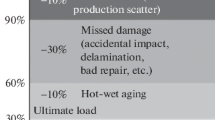Abstract
In the aircraft operation, the metallic airframes are usually exposed to the extreme loading conditions during the flights due to which the risk of failure should be assessed and held to an allowed level to prevent the associated loss. If the components are inspectable, the components should be inspected routinely so that the fatigue damage can be detected before failure, which usually requires non-destructive inspection (NDI) techniques to evaluate the damage growth during the maintenance action. There have been several methods to determine the inspection plan in the aircraft industry for this purpose. In this study, four methods: Aircraft Structural Integrity Program (ASIP), Reliability Centered Maintenance Analysis (RCMA), Modified RCMA and Stochastic Life APproach (SLAP), are selected to evaluate the performance in comparative manner for a couple of crack growth problems with the aim to help the maintenance planning engineers select their own inspection plan properly based on the performance of each method. The methods are briefly reviewed, implemented, and examined in comparison for the fatigue test data of the fastener hole specimen under an aircraft load spectrum.














Similar content being viewed by others
Availability of data and material
The raw data used for the comparison study is from the reference, “Gordon DE, Kirschner SB, Brubaker LE, Koepsel K, Manning SD (1986) Advanced Durability Analysis. Volume III. Fractographic Test Data. Air Force Wright Aeronautical Laboratories. TR-86–3017”.
Code availability
Not applicable.
References
Iyyer N, Sarkar S, Merrill R, Phan N (2007) Aircraft life management using crack initiation and crack growth models–P-3C Aircraft experience. Int J Fatigue 29:1584–1607. https://doi.org/10.1016/j.ijfatigue.2007.03.017
US Department of Defense (2016) Department of Defense Standard Practice Aircraft Structural Integrity Program (ASIP). MIL-STD-1530D.
Manning SD, Yang JN, Pretzer FL, Marler JE (1992) Reliability centered maintenance for metallic airframes based on a stochastic crack growth approach. In: Advances in fatigue lifetime predictive techniques. ASTM International. https://doi.org/10.1520/STP24172S
Valdebenito MA, Schuëller GI (2010) Design of maintenance schedules for fatigue-prone metallic components using reliability-based optimization. Comput Methods Appl Mech Eng 199:2305–2318. https://doi.org/10.1016/j.cma.2010.03.028
Pattabhiraman S, Gogu C, Kim NH, Haftka RT, Bes C (2012) Skipping unnecessary structural airframe maintenance using an on-board structural health monitoring system. Proc Inst Mech Eng O J Risk Reliab 226:549–560. https://doi.org/10.1177/1748006X12459157
Grooteman F (2008) A stochastic approach to determine lifetimes and inspection schemes for aircraft components. Int J Fatigue 30:138–149. https://doi.org/10.1016/j.ijfatigue.2007.02.021
Kim SJ, Kim HS, Choi JH (2020) Modified reliability centered maintenance analysis considering probability of detection. J Aerosp Inf Syst 17:240–247. https://doi.org/10.2514/1.I010800
Gordon DE, Kirschner SB, Brubaker LE, Koepsel K, Manning SD (1986) Advanced durability analysis. Volume III. Fractographic test data. air force wright aeronautical laboratories. TR-86–3017.
Yang JN, Manning SD (1994) Aircraft fleet maintenance based on structural reliability analysis. J Aircr 31:419–425. https://doi.org/10.2514/3.46502
Federal Aviation Administration Advisory Circular (2011) Damage tolerance and fatigue evaluation of structure. 25.571–1D.
Heida JH, Grooteman FP (1998) Airframe inspection reliability using field inspection data. Netherlands Aerospace Centre.
Yang JN, Chen S (1985) Fatigue reliability of structural components under scheduled inspection and repair maintenance. In: Probabilistic methods in the mechanics of solids and structures, Springer, Berlin, Heidelberg, pp 559–568. https://doi.org/10.1007/978-3-642-82419-7_51
Yang JN, Chen S (1985) Fatigue reliability of gas turbine engine components under scheduled inspection maintenance. J Aircr 22:415–422. https://doi.org/10.2514/3.45140
Manning SD, Yang JN (1986) Advanced durability analysis. Volume I. Analytical Methods. Air Force Wright Aeronautical Laboratories. TR-86–3017.
Manning SD, Yang JN (1989) Advanced durability analysis. Volume II. Analytical predictions, test results and analytical correlations. Air Force Wright Aeronautical Laboratories. TR-86–3017.
Funding
Not applicable
Author information
Authors and Affiliations
Corresponding author
Ethics declarations
Conflicts of interest
Not applicable.
Additional information
Publisher's Note
Springer Nature remains neutral with regard to jurisdictional claims in published maps and institutional affiliations.
Rights and permissions
About this article
Cite this article
Kim, S.J., Choi, JH. Comparative Study for Inspection Planning of Aircraft Structural Components. Int. J. Aeronaut. Space Sci. 22, 328–337 (2021). https://doi.org/10.1007/s42405-020-00319-x
Received:
Revised:
Accepted:
Published:
Issue Date:
DOI: https://doi.org/10.1007/s42405-020-00319-x



